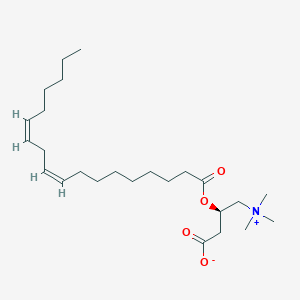Details of Metabolite
| Full List of Protein(s) Regulating This Metabolite | ||||||
|---|---|---|---|---|---|---|
| Oxidoreductases (EC 1) | ||||||
| Formyltetrahydrofolate dehydrogenase (ALDH1L2) | Click to Show/Hide the Full List of Regulating Pair(s): 1 Pair(s) | |||||
| Detailed Information |
Protein Info
 click to show the details of this protein click to show the details of this protein
|
|||||
| Regulating Pair |
Experim Info
 click to show the details of experiment for validating this pair click to show the details of experiment for validating this pair
|
[1] | ||||
| Introduced Variation | Mutation of ALDH1L2 | |||||
| Induced Change | Linoelaidylcarnitine concentration: increase (FC = 7.14) | |||||
| Summary | Introduced Variation
|
|||||
| Disease Status | Genetic disorders of keratinisation [ICD-11: EC20] | |||||
| Details | It is reported that mutation (patients) of ALDH1L2 leads to the increase of linoelaidylcarnitine levels compared with control group. | |||||
| Transferases (EC 2) | ||||||
| Succinate-hydroxymethylglutarate CoA-transferase (SUGCT) | Click to Show/Hide the Full List of Regulating Pair(s): 1 Pair(s) | |||||
| Detailed Information |
Protein Info
 click to show the details of this protein click to show the details of this protein
|
|||||
| Regulating Pair |
Experim Info
 click to show the details of experiment for validating this pair click to show the details of experiment for validating this pair
|
[2] | ||||
| Introduced Variation | Knockout of Sugct | |||||
| Induced Change | Linoelaidylcarnitine concentration: increase | |||||
| Summary | Introduced Variation
|
|||||
| Disease Status | Diabetes mellitus [ICD-11: 5A14] | |||||
| Details | It is reported that knockout of Sugct leads to the increase of linoelaidylcarnitine levels compared with control group. | |||||
If you find any error in data or bug in web service, please kindly report it to Dr. Zhang and Dr. Mou.

